Size
Adult male killer whales are larger overall than their female counterpart including features such as pectoral flippers, dorsal fins, tail flukes, and girth.
The largest recorded male killer whale was 9.8 m (32 ft.) in length and weighed 10,000 kg (22,000 lbs.) The largest recorded female was 8.5 m (28 ft.) and weighed 7,500 kg (16,500 lbs.).
Data from Icelandic killer whales (North Atlantic type 1) indicate that an average-size male is about 5.8 to 6.7 m (19 to 22 ft.) long, while females averaged 4.9 to 5.8 m (16 to 19 ft.) long.
Killer whale sizes vary significantly between different ecotypes.
- Male Antarctic type A killer whales can reach lengths of 9.2 m (30 ft.) making them the largest known killer whales.
- The smallest killer whale ecotype is the Antarctic type C killer whales in which adult females average 5.2 m (17 ft.) and adult males average 5.6 m (18 ft.) in length and can reach a maximum of 6.1 m (20 ft.).
At SeaWorld, average size for adult males is 6.6 m (21.7 ft.) Two of the largest adult male killer whales at SeaWorld weigh 4,340 kg (9,570 lbs.) and 5,380 kg (11,860 lbs.).
At SeaWorld, average size for females is 5.5 m (18 ft.) and 2,442 kg. (5,384 lbs.) SeaWorld's adult female whales range in weight from 2,313 kg (5,100 lbs.) to 3,719 kg (8,200 lbs.).
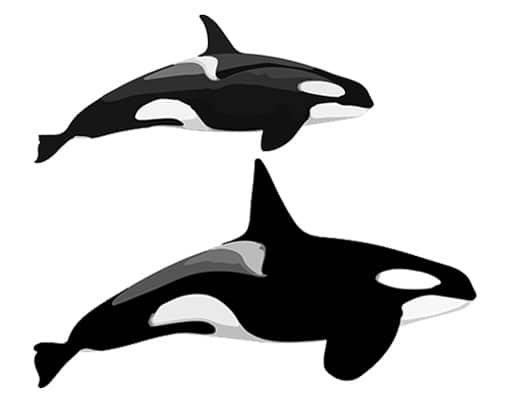
Adult male killer whales are larger overall than their female counterparts.
Body Shape
The general body shape of a killer whale is roughly cylindrical but tapering at both ends. This characteristic fusiform shape is quite energy efficient for swimming. Compared to other body shapes, this body shape creates less drag (the opposing force an object generates as it travels through water).
Coloration
Killer whales are black and white, with a gray patch called a "saddle" or a "cape" on the back, just behind the dorsal fin.
The large areas of black and white are distinctly separate.
- The entire dorsal (top) surface and pectoral flippers are black except for the gray saddle.
- The ventral (bottom) surface, lower jaw, and undersides of the tail flukes are mostly white. The undersides of the tail flukes are fringed with black.
- An oval, white "eyespot" is just above and slightly behind each eye.
- The size and shape of a killer whale's white areas and gray saddle vary greatly among ecotypes.
- Conspicuous eye and saddle patches may help killer whales in groups coordinate social interactions, hunting, and swimming in formation.
The distinctive coloration of killer whales is a type ofdisruptive coloration, a pattern that obscures the outline of an animal by contradicting the animal's body shape. In the flickering, filtered sunlight of the sea, other animals may not recognize a killer whale as a potential predator.
Killer whales are countershaded: the dorsal (top) surface is darker than the ventral (underneath) surface. When viewed from above, a countershaded animal blends in with the darker ocean depths. When viewed from below, the lighter belly surface blends in with the brighter sea surface.
While extremely rare, white killer whales have been observed. In British Columbia, one such animal was diagnosed with Chédiak-Higashi Syndrome, an inherited fatal disorder characterized by loss of pigmentation and not surviving to adulthood. Others appear to be full-grown adults and the cause of their white coloration is unknown.

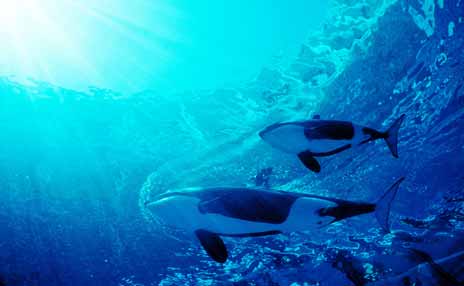
Pectoral Flippers
A killer whale's forelimbs are adapted for swimming. A killer whales uses its rounded, paddlelike pectoral flippers to steer and, with the help of the flukes, to stop.
Pectoral flippers have the major skeletal elements of the forelimbs of land mammals, but they are shortened and modified. The skeletal elements are rigidly supported by connective tissue.
Blood circulation in the pectoral flippers adjusts to help maintain body temperature.
The pectoral flippers of male killer whales are proportionately larger than those of females. A large male killer whale may have pectoral flippers as large as 2 m (6.5 ft.) long and 1.2 m (4 ft.) wide. A female's pectoral flippers are significantly smaller.
A killer whale's pectoral flipper contains 5 digits much like the fingers on a human hand.
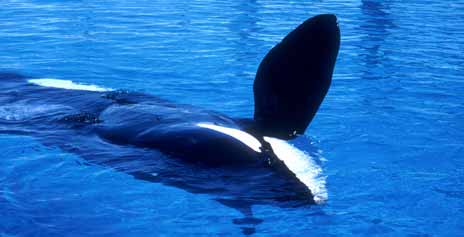
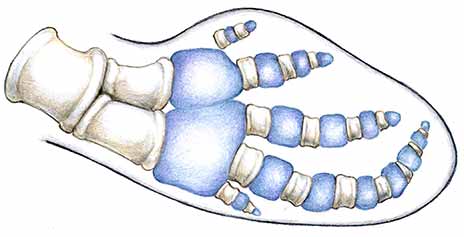
Flukes
Each lobe of the two-lobed tail is called afluke. Flukes are flat pads of tough, dense, fibrous connective tissue, completely without bone or cartilage.
Although killer whales have 50 to 54 vertebrae, no bones extend into the flukes. Without bones or even cartilage in the flukes, it is not unusual to see them curved, especially in larger males.
A large male killer whale may have tail flukes measuring 2.75 m (9 ft.) from tip to tip.
Longitudinal muscles in the back one-third of the body (both above and below the spine) move the flukes up and down.
Like the arteries of the flippers, the arteries of the flukes are surrounded by veins to help maintain body temperature.
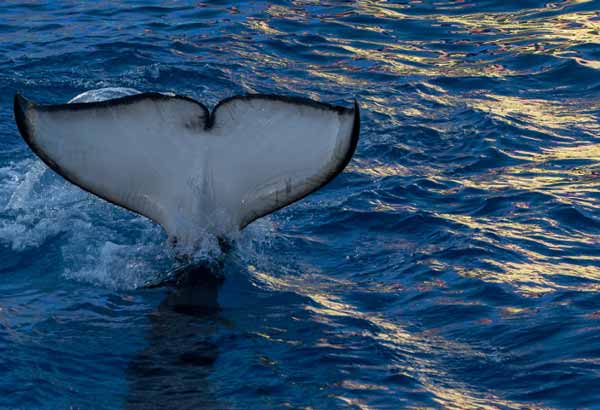
Dorsal Fin
Like the flukes, the dorsal fin is made of dense, fibrous connective tissue, without bones or cartilage.
Dorsal fin size and shapes vary between ecotypes.
The dorsal fin of a male killer whale is proportionately larger than that of a female.
- In adult males, the dorsal fin is tall and triangular. Reaching a height of up to 1.8 m (6 ft.) in a large adult male, it is the tallest dorsal fin of all cetaceans.
- In most females, the dorsal fin is slightly falcate (backward-curving) and smaller — about 0.9 to 1.2 m (3 to 4 ft.) tall.
As in the flukes and the flippers, arteries in the dorsal fin are surrounded by veins to help maintain body temperature.
Like the keel of a boat, the dorsal fin may help stabilize a killer whale as it swims at high speeds, but a fin is not essential to a whale's balance.
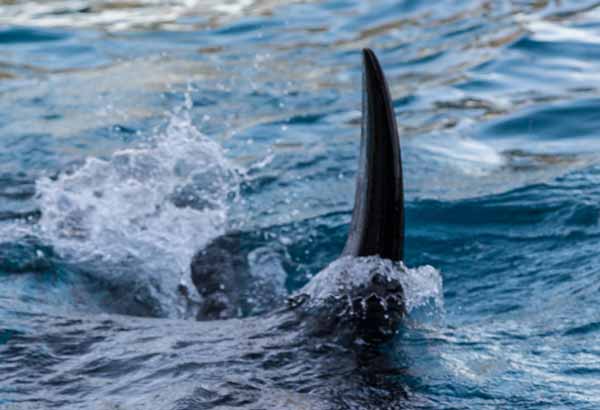
Dorsal fin irregularities in killer whales observed in ocean are rarely seen, however, some have irregular-shaped dorsal fins: they may be curved, wavy, twisted, scarred, or bent. This may occur in male or female dorsal fins.
About 4.7% of wild adult male killer whales around British Columbia were observed with dorsal fin abnormalities. For the observed wild Norwegian population, the rate was 0.57%. But of the adult male killer whales that have been photo-identified in the waters around New Zealand, 23% (7 out of 30) had collapsing or bent dorsal fins.
It is not fully understood why wild killer whale populations develop abnormal dorsal fins or why the observed killer whale males around New Zealand had such a high rate of dorsal fin abnormalities compared to other studied populations. Researcher theories include these observed abnormalities may be attributed to age, stress, and/or attacks from other killer whales. However, as killer whales at SeaWorld tend to spend more time at the surface working with their trainers, and many of the males have slumped or bent dorsal fins, it seems probable that time spent at the surface may be a contributing factor.
Killer whales in the Eastern Tropical Pacific tend to have barnacles (Xenobalanus spp.) attached to the back edge of their dorsal fins.
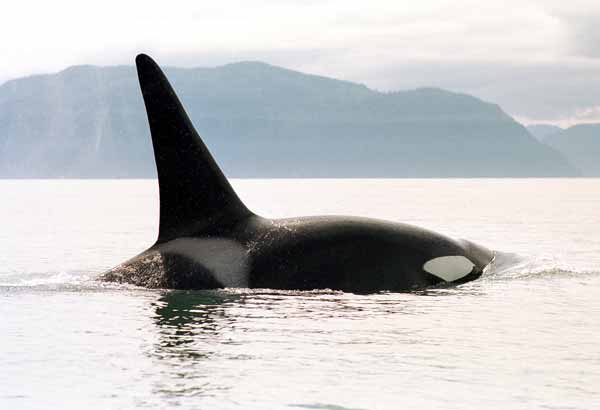
Head
A killer whale has an indistinct rostrum (snout-like projection).
A single blowhole on top of the head is covered by a muscular flap. A killer whale breathes through its blowhole. The blowhole is relaxed in a closed position, and the flap provides a water-tight seal. To open its blowhole, a killer whale contracts the muscular flap.
A killer whale's eyes are on each side of its head, just behind and above the corner of its mouth, and in front of its white eyespot.
A killer whale's eyes are about the same size as the eyes of a cow. Glands at the inner corners of the eye sockets secrete an oily, jellylike mucus that lubricates the eyes, washes away debris, and probably helps streamline the eyes as a killer whale swims.
Ears are small inconspicuous dimples just behind each eye, with no external flaps or pinnae. These small external ear openings lead to reduced ear canals that are not connected to the middle ears.
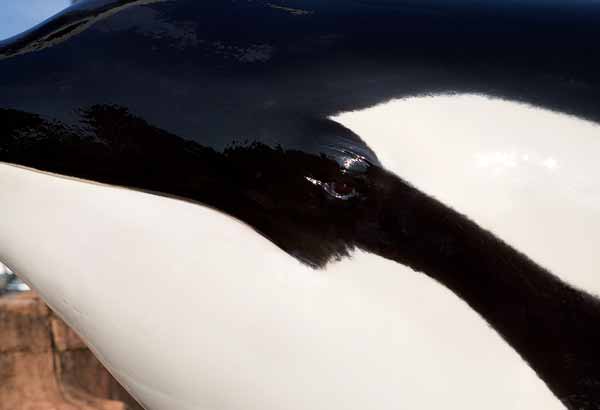
Teeth
A killer whale's large teeth are conical and interlocking. Toothed whales have only one set of teeth; they are not replaced once lost.
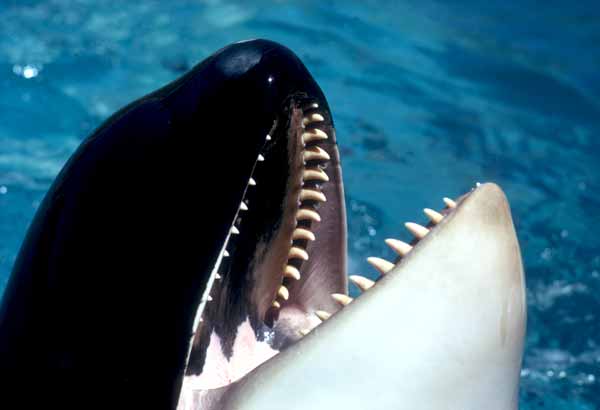
The number of teeth varies among individuals. There are usually 10 to 14 teeth on each side of each jaw (40 to 56 teeth total).
A killer whale does not chew its food — instead its teeth are adapted to grasp prey and tear its food into smaller chunks.
The teeth of killer whales begin to erupt from several to 11 weeks of age, which corresponds with the time that calves are seen taking solid food from their mothers.
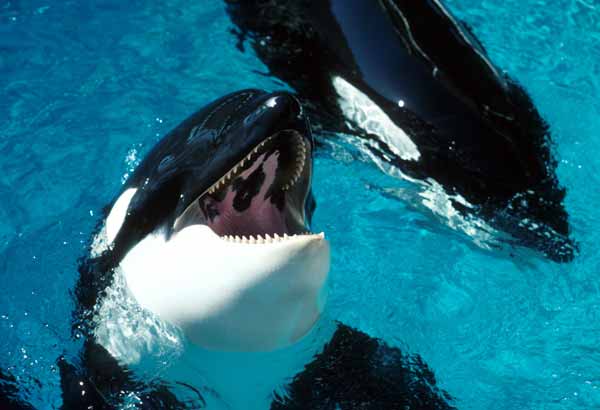
Teeth are about 7.6 cm (3 in.) long and about 2.5 cm (1 in.) in diameter.
Extensive wear has been noted on the teeth of older individuals. Most adult North Atlantic type 1 killer whales have severely, worn-down teeth, which is consistent with a diet of suctioning up small fishes. Adult offshore killer whales in the Northeast Pacific also have highly worn teeth, likely caused by a diet that includes sharks with highly abrasive skin.
Blubber
A killer whale's blubber layer lies beneath the dermis and measures from 7.6 to 10 cm (3 to 4 in.) thick. Blubber is a layer of fat reinforced by collagen and elastic fibers. In general, blubber has a number of important functions:
- Contributing to a killer whale's streamlined shape, which helps increase swimming efficiency
- Storing fat, which provides energy when food is in short supply
- Reducing heat loss, which is important for thermoregulation
Skin
A killer whale's dermis (skin) is smooth. The outer layer continually and rapidly renews itself, and the old skin sloughs off.
The increased skin cell turnover increases swimming efficiency by creating a smooth body surface which reduces drag.
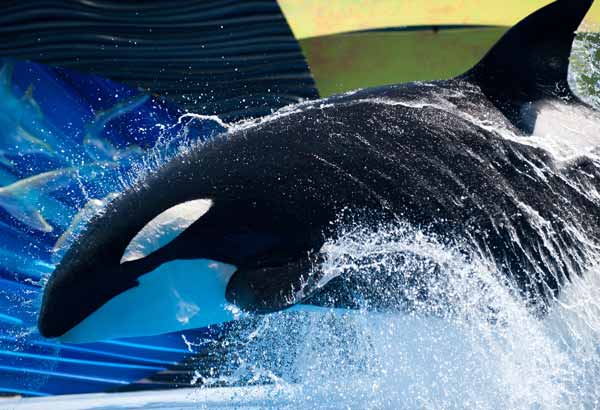
Physical Differences in Ecotypes
The five forms of Antarctic killer whales look different and are easier to tell apart.
- Type A killer whales have a medium-size, horizontal eye patch and have a very faint dorsal saddle. These are the largest killer whale ecotypes.
- Large type B killer whales have a very large, horizontal eye patch. The small type B killer whale has a slightly narrower and slanted eye patch. Both types have a dorsal saddle, a dorsal cape (dark gray covering on the back), and can have a yellowish cast due to a layer of diatoms on their skin.
- Type C killer whales have a small, forward-slanting eye patch and a dorsal saddle and often have a yellowish cast due to a covering of diatoms. These are the smallest type of killer whale.
- Type D killer whales have an extremely, tiny eye patch, a bulbous melon (forehead), and a very faint saddle.
Experts note subtle differences between the resident, transient, and offshore killer whales of the eastern North Pacific Ocean.
- In general, resident killer whales are larger and have a rounded tip on the dorsal fin, which is falcate (curved back) in adult females and tall and triangular in males. The dorsal saddle may contain some black areas.
- Transient killer whales tend to be smaller and have a more pointed dorsal fin. The dorsal saddle does not contain any black areas. Offshore killer whales are more similar in appearance to the resident ecotype, although they are smaller than either the residents or transients and they have a faint saddle.
North Atlantic killer whale ecotypes.
- Type 1 killer whales are much smaller than type 2. They have very distinct white eye patches and a conspicuous saddle.
- Type 2 killer whales are one of the largest ecotypes, with males reaching 8.5 m (29 ft.) lengths. They have very distinct white patches, a slanted-back eye patch, and a faint saddle.
Photo-Identification of Individual Whales
Of the groups of killer whales studied, researchers have learned to recognize many individual killer whales from photographs, especially photos of the dorsal fin and saddle patch.
- Researchers photograph the dorsal fin when the whale rises out of the water to breathe. This action exposes the most markings on the back and dorsal fin. Studying the photos, these researchers recognize subtle differences in whales' body appearance.
- Researchers identify individuals using many features including dorsal fin shape, nicks in the dorsal fin, relative body size, pigmentation patterns of saddle patches and eye patches, scars, deformities, detail of tail fluke edges, encrustations, blemishes, and rake marks.
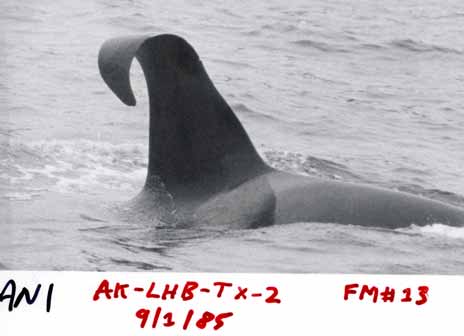
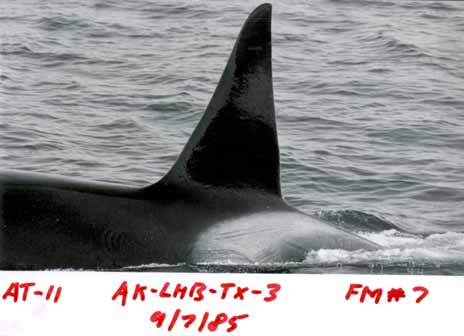
Above are historic field images used in killer whale photo identification.
Post a Comment for "Do Blue Whales Have Tail Flukes Do Killer Pakicetus Have Tail Flukes"